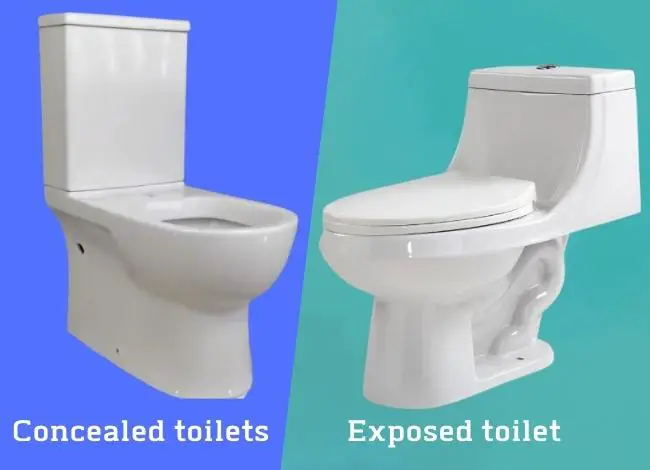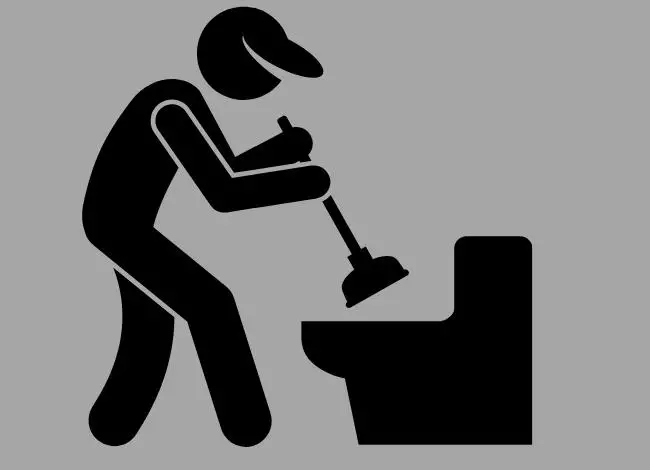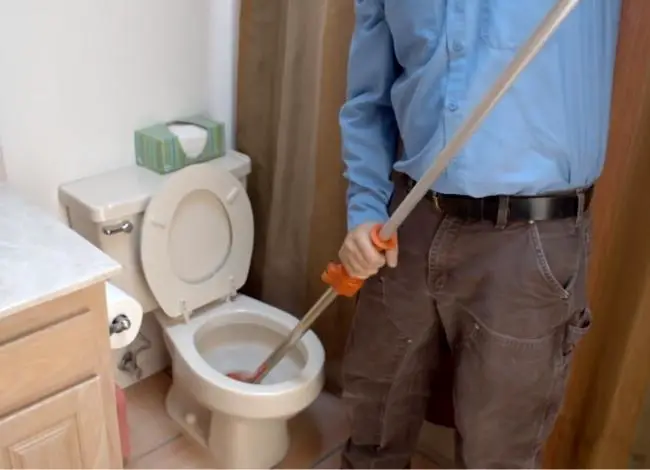When you hear the term toilet trapway, it might sound technical, but it is one of the most important parts of your toilet’s design. The trapway is the curved passage inside the toilet bowl that connects directly to the drainpipe. It is typically shaped like an S or P and serves two critical functions:
- It carries away all waste and water from the toilet bowl into the sewer line or septic tank.
- It maintains a water seal that blocks sewer gases and odors from escaping into your bathroom.
Without a proper trapway, your toilet would either clog constantly or allow foul smells to enter the room. That’s why the toilet trapway plays a central role in both hygiene and functionality.
The shape and size of the trapway affect how efficiently waste moves through the toilet. A well-designed trapway creates a powerful siphon effect, pulling waste down with minimal water use. On the other hand, a poorly designed or narrow trapway is more likely to clog.

Concealed (Skirted) Toilet Trapway
One of the biggest advancements in modern bathroom design is the concealed toilet trapway, often called a skirted trapway. Instead of showing the curved S-shaped pipe on the outside, the trapway is hidden behind a smooth surface that extends down the side of the toilet. This not only makes the toilet look sleek but also improves functionality.
Why Homeowners Choose Concealed Trapways
-
Easy Cleaning
The smooth skirted surface eliminates grooves, bends, and crevices where dust, dirt, and bacteria usually collect. With a quick wipe, the toilet looks spotless—something that is much harder with exposed trapways. -
Modern Aesthetics
A concealed toilet trapway gives the bathroom a clean, minimalistic look. It blends well with contemporary bathroom styles, creating a spa-like feel. -
Hidden Hardware
On traditional toilets, bolts and caps are visible. With concealed trapways, all hardware is tucked away neatly, leaving a streamlined finish. -
Durability and Protection
Since the trapway and bolts are shielded, they’re less prone to external damage or rusting, which adds to the toilet’s lifespan.
Example of a Skirted Toilet Trapway
A good example is the WOODBRIDGE Modern Toilet, a highly rated option in today’s market:
Recommended Skirted Trapway- WOODBRIDGE Modern Toilet
- Bowl Shape: Elongated (for comfort seating)
- Type: Available in both one-piece and two-piece designs
- Flush System: Dual flush with 1.28 GPF for water efficiency
- Height: 15.5 to 16.5 inches (comfort height)
- MaP Score: 1000 grams (indicating powerful, clog-free flushing)
- Seat: Soft-closing, included with purchase
- Finish: Chrome flush button for a premium look
- System: Siphon jet flushing, engineered to reduce clogs
This example highlights why concealed trapway toilets have become so popular—they combine modern looks, efficient flushing, and easy maintenance in one package.
Exposed Toilet Trapway
In contrast to the modern concealed style, the exposed toilet trapway is the more traditional design. Here, the S-shaped curve of the trapway is clearly visible on the outside of the toilet bowl. While some people consider it outdated, exposed trapways still hold value for many homeowners due to their simplicity and classic appearance.
Benefits of an Exposed Trapway
- Classic Look
The exposed curve gives bathrooms a traditional charm. Many older homes still use this style, and some homeowners prefer to maintain that vintage aesthetic. - Lower Cost
Toilets with exposed trapways generally cost less than skirted versions. For those on a tight budget, this makes them an attractive option. - Easy Access for Repairs
Since bolts, caps, and the trapway are visible, plumbers can quickly access parts for adjustments or repairs. This can reduce maintenance costs over time.
Downsides of Exposed Trapways
Despite these advantages, there are several drawbacks:
- Harder to Clean – The visible bends and crevices attract dust, grime, and bacteria, requiring more effort to keep clean.
- Visible Hardware – Bolts and bolt caps are not hidden, which may make the toilet look less polished compared to a concealed design.
- Hygiene Concerns – Because of the grooves and hard-to-reach areas, germs, mold, and mildew can build up faster if cleaning is neglected.
Who Should Choose an Exposed Trapway?
An exposed toilet trapway is best for homeowners who:
- Prefer a traditional bathroom style
- Are working with a lower budget
- Don’t mind spending a little more time on regular cleaning
Skirted vs. Exposed Toilet Trapway – A Comparison
Choosing between a skirted (concealed) toilet trapway and an exposed toilet trapway often comes down to lifestyle, cleaning habits, budget, and bathroom design preferences. Both function in the same way—guiding waste from the bowl to the drain—but they differ in aesthetics, maintenance, and long-term value.
Appearance
- Skirted Trapway: Features a smooth, modern surface that hides the S-shaped pipe. It gives the toilet a streamlined, minimalist look that blends well with contemporary bathrooms.
- Exposed Trapway: The curvy trapway is visible, creating a more traditional style. Some people like the character it adds, especially in vintage-themed homes.
Cleaning & Maintenance
- Skirted Trapway: Much easier to clean because there are no grooves or awkward bends. A simple wipe-down keeps it spotless.
- Exposed Trapway: Cleaning is more challenging since dust, germs, and bacteria can collect in the bends and crevices.
Cost
- Skirted Trapway: Usually costs more due to modern design and additional materials.
- Exposed Trapway: More budget-friendly, making it a common choice for cost-conscious buyers.
Hardware & Bolts
- Skirted Trapway: Nuts and bolts are hidden in a separate chamber, keeping the design sleek.
- Exposed Trapway: Bolts and bolt caps remain visible, which some consider less attractive.
Hygiene
- Skirted Trapway: Less prone to germs, mold, and mildew buildup because of its smooth surface.
- Exposed Trapway: More vulnerable to bacteria growth due to multiple bends and edges.
Quick Comparison Table
| Factor | Skirted/Concealed Toilet Trapway | Exposed Toilet Trapway |
|---|---|---|
| Appearance | Modern, sleek, smooth | Traditional, visible curves |
| Cleaning | Easy, fewer crevices | Difficult, bacteria-prone |
| Cost | Slightly higher | More affordable |
| Hardware | Hidden bolts | Visible bolts |
| Hygiene | Cleaner, fewer germs | More vulnerable to mold/mildew |
Toilet Trapway Sizes – Do They Matter?
When buying a toilet, most people check the flush system, water usage, or bowl shape, but few pay attention to the toilet trapway size. In reality, the trapway’s width plays a huge role in how effectively your toilet handles waste and how often it clogs.
Why Size Matters
The toilet trapway is like the highway for waste. The wider it is, the more traffic (waste and water) it can carry at once. A narrow trapway restricts flow and increases the chance of clogging, while a wider one allows smoother passage.
Common Trapway Sizes
- 2-inch trapway: Standard in most traditional toilets. Works fine for average use but more prone to clogging if bulkier waste is flushed.
- 2 1/8 to 2 3/8-inch trapway: Found in many modern toilets. This slightly wider size provides a better balance between waste clearance and flush pressure.
- 3 to 4-inch trapway: Usually used in commercial or public restrooms where higher waste volumes must be managed. Rare in residential toilets.
2-inch vs. 4-inch Trapway – Which Is Better?
- A 2-inch trapway creates more pressure during flushing because the waste is forced through a narrower passage. However, it can’t handle large amounts of waste as efficiently.
- A 4-inch trapway can pass a much larger volume of waste, making clogs less likely. But since the channel is wider, the pressure of the flush may decrease slightly.
For most homes, the 2 1/8 to 2 3/8-inch trapway is considered ideal—it provides a strong flush while reducing clog risks.
Updated Market Trend (2025)
Modern toilet brands are now offering fully glazed trapways, where the inside of the passage is coated to make it smoother. This reduces friction, prevents buildup, and makes clogs even less likely. Combined with powerful flush valves (3-inch or more), these toilets perform significantly better than older models.
How to Unclog a Toilet Trapway
Even the most efficient toilet trapway can sometimes get clogged. This usually happens when large waste, too much toilet paper, or foreign objects enter the bowl. Knowing how to deal with these situations can save you from costly plumbing bills and unpleasant bathroom experiences.
1. Using a Plunger
The plunger is the most common and effective tool for unclogging.

- Choose a beehive or flange plunger (they fit better into toilet bowls than standard sink plungers).
- Place it firmly over the drain opening.
- Push and pull in quick motions to create suction and pressure.
- After several attempts, the clog usually loosens, allowing the trapway to clear.
2. Using a Toilet Auger (Snake)
For tougher clogs deeper in the toilet trapway, a plumbing auger works best.

- Insert the flexible cable into the trapway opening.
- Rotate the handle while gently pushing it forward.
- The auger either breaks the clog apart or hooks it so you can pull it out.
- Slowly retract the cable to avoid scratching the porcelain.
3. Using Natural Cleaning Solutions
If you prefer chemical-free methods, you can use a mix of vinegar and baking soda or borax.
- Pour one cup of baking soda and two cups of vinegar into the bowl.
- Let it sit for 20–30 minutes to dissolve buildup.
- Flush with hot (not boiling) water to push everything through the trapway.
4. Using Commercial Toilet Cleaners
There are strong commercial drain cleaners designed specifically for toilets. These can help dissolve organic matter inside the trapway. However, use them sparingly, as harsh chemicals may damage older porcelain finishes or septic systems.
5. Calling a Professional Plumber
If all else fails, the clog may be too deep or complex to clear with household tools. A professional plumber can use power augers or hydro-jetting systems to completely clear the toilet trapway and restore proper flow.
Final Conclusion
The toilet trapway may not be the most glamorous feature of a bathroom fixture, but it is one of the most critical. From ensuring efficient waste removal to preventing unpleasant odors, the trapway directly impacts your toilet’s performance, hygiene, and ease of cleaning.
- Concealed trapways (skirted designs) are modern, easy to maintain, and more hygienic.
- Exposed trapways offer affordability and easier access for repairs but require more cleaning effort.
- Trapway size matters—a wider, fully glazed trapway helps reduce clogs while maintaining strong flushing power.
- With proper care and occasional unclogging methods, your toilet trapway can function smoothly for years.
Whether you’re renovating your bathroom or choosing your very first toilet, don’t overlook the importance of the trapway. By selecting the right type and size, you’ll enjoy a more comfortable, hygienic, and reliable bathroom experience.
Frequently Asked Questions (FAQ)
Q1: What is a toilet trapway?
A toilet trapway is the curved channel inside or behind the toilet that carries waste from the bowl into the drainpipe while maintaining a water seal to block sewer gases.
Q2: What is the difference between concealed and exposed toilet trapways?
A concealed (skirted) trapway hides the S-shaped curve behind a smooth surface, making it easier to clean and more modern in appearance. An exposed trapway leaves the pipe visible, giving a traditional look but requiring more cleaning.
Q3: Does toilet trapway size really matter?
Yes. A wider trapway (2 1/8–2 3/8 inches) reduces clogging risks and improves waste clearance compared to the standard 2-inch trapway. Larger trapways, like 4 inches, are common in commercial settings but less necessary for homes.
Q4: What is the standard trapway size for most toilets?
Most residential toilets use trapways that are 2 to 2 3/8 inches wide, paired with a 3-inch flush valve. This combination balances strong flushing power with reduced clog risk.
Q5: How can I unclog a toilet trapway at home?
You can use a plunger, a toilet auger (snake), or natural solutions like vinegar and baking soda. If the clog persists, commercial cleaners or professional plumbing services may be needed.
Q6: Which is better, a skirted trapway or an exposed one?
It depends on your needs. Skirted trapways are easier to clean and look modern but cost slightly more. Exposed trapways are cheaper and simpler to repair but harder to keep spotless.
Q7: Do all toilets have a trapway?
Yes, every toilet includes a trapway as part of its plumbing design. Without it, the toilet would not function properly or block sewer gases.
Hi, this is Robert Crossan, the owner of this website, has 17 years of experience in the installation, maintenance, and repair of toilets and plumbing systems. After completing the Level 2 Basic Plumbing course in 2005, I started working in both domestic and commercial buildings as a professional plumber. So I can figure out the core difference between different toilet models and brands. It also helped me monitor their work performance and setbacks.